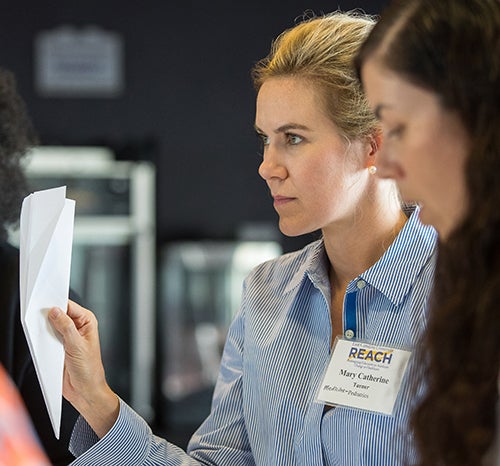AIMING HIGH
Clinicians, educators learn about boosting quality in health
Twenty-five health sciences professionals and administrators from East Carolina University and Vidant Health gathered for a daylong session recently at Dowdy-Ficklen Stadium’s Club Level to learn about improving quality in health care delivery. And to build paper airplanes.
They are the second cohort in the Brody School of Medicine’s Teachers of Quality Academy (TQA 2.0), a professional development program aimed at arming clinicians and educators with the skills necessary to practice and teach the new competencies of health systems science: patient safety, quality improvement, population health and team-based care.
TQA 2.0 program director Dr. Niti Armistead, who’s a clinical associate professor of general internal medicine at Brody and the senior medical director for quality at Vidant Medical Center, said the decision to become involved was easy for her.
“Through this program we gain a whole army of faculty working on quality,” she said. “Many of these participants are frontline people who have lots of influence on driving quality results. This is the best way to achieve our quality goals.”
TQA grew out of Brody’s REACH (Redesigning Education to Accelerate Change in Healthcare) initiative, made possible by a five-year, $1 million grant in 2013 from the American Medical Association. Brody was one of only 11 medical schools nationwide to receive this level of funding and join the inaugural group of consortium schools tasked with developing ways to better prepare the nation’s future health care workforce.
The first learning session for 2016-17 TQA participants culminated in a paper airplane-building contest.
“This activity demonstrates key aspects of change theory as well as team science,” said Dr. Tim Reeder, who led the exercise. Reeder is an associate professor of emergency medicine, TQA 1.0 fellow, and director of the LINC (Leaders in Innovative Care) Scholars program at Brody – another REACH component.
“It illustrates the idea of a process flow within a health care delivery system and the importance of things like communication and standardization in improving that system,” Reeder said.

Dr. Mary Catherine Turner, clinical assistant professor in internal medicine/pediatrics, listens to instructions about building a paper airplane during a recent TQA learning exercise.
Teams of six or seven participants were instructed to assemble four different types of paper airplanes and deliver them, in a predetermined order, to a “customer” who also served as a quality inspector. There were three rounds of production, each with a new caveat and discussion afterwards. Teams competed to see who could produce the most airplanes.
Dr. Robert Hartman, clinical assistant professor of pediatric cardiology and a member of the winning team, said, “We transitioned from ‘somebody needs to do this’ in the first round, to ‘you need to do this’ and ‘I need to do this’ in the last round. We also identified bottlenecks in the work flow early on and assigned more people to those areas in later rounds.”
“You won’t deliver the best outcomes with randomness,” Reeder responded. “As physicians, we often expect to do things individually, randomly, and get great outcomes. But even the simplest task requires stepping back, planning and using the strengths of each person on the team.”
Reeder pointed out the inefficiencies that resulted when teams passed their airplanes back and forth across the table during construction, rather than having team members touch each airplane only once in a linear process.
“People naturally gravitate toward certain roles; we should embrace that,” he said. “Data show that outcomes improve when you do that.”
Participant Jane Trapp, director of didactic education for ECU’s Physician Assistant Studies, noted that one key to stepping up production involved learning from the mistakes made in earlier rounds and making adjustments accordingly.
“The iterative process is important,” Reeder said. “We can’t solve all the problems within a system in one fell swoop.”
Reeder went on to define failure as “an attempt at learning” and urged participants to consider how they could translate the concepts they’ve learned during their future interactions with students.
“As educators, we need to let students fail – not always jump in and correct them,” said Dr. Janet Tillman, clinical assistant professor in ECU’s Doctor of Nursing Practice Program. “We should not be afraid to try new things, especially in low-risk situations.”

Dr. Lorie Sigmon, clinical associate professor in nursing, participates in a recent Teachers of Quality Academy learning session.